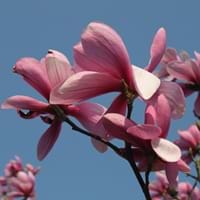Life Span
Annual and Perennial
Perennial
Type
Bulb or Corm or Tuber
Tree
Origin
Latin America and the Caribbean, Central America, Micronesia
Hybrid origin
Types
Hannah Yams, Japanese Sweet Potatoes
Not Available
Number of Varieties
Not Available
Habitat
Cold Regions, Tropical regions
Not Available
USDA Hardiness Zone
11-12
6-9
Sunset Zone
21,22
3b, 4, 5, 6, 7, 8, 9, 14, 15, 16, 17, 18, 19, 20, 21, 22, 23, 24
Habit
Vining/Climbing
Oval or Rounded
Minimum Width
Not Available
Flower Color
Not Available
Pink, Violet
Flower Color Modifier
Bicolor
Bicolor
Fruit Color
Not Available
Red
Leaf Color in Spring
Green, Purple, Light Green, Chartreuse, Bronze
Light Green
Leaf Color in Summer
Light Green
Green
Leaf Color in Fall
Several shades of Green
Yellow, Yellow green
Leaf Color in Winter
Light Green
Not Available
Leaf Shape
Heart-shaped
Oblong
Plant Season
Spring, Summer, Fall, Winter
Spring
Sunlight
Full Sun, Partial Sun
Full Sun, Partial Sun
Growth Rate
Very Fast
Fast
Type of Soil
Clay, Loam, Sand
Clay, Loam, Sand
The pH of Soil
Acidic, Neutral, Alkaline
Acidic, Neutral
Soil Drainage
Well drained
Well drained
Bloom Time
Late Fall, Early Winter, Winter
Spring
Tolerances
Drought
Not Available
Where to Plant?
Ground, Pot
Ground
How to Plant?
Stem Cutting, Tuber propagation
Seedlings, Stem Cutting
Plant Maintenance
Medium
Medium
Watering Requirements
Average Water Needs, Needs a lot of water initially
Requires regular watering
In Summer
Lots of watering
Lots of watering
In Spring
Moderate
Moderate
In Winter
Average Water
Average Water
Soil pH
Acidic, Neutral, Alkaline
Acidic, Neutral
Soil Type
Clay, Loam, Sand
Clay, Loam, Sand
Soil Drainage Capacity
Well drained
Well drained
Sun Exposure
Full Sun, Partial Sun
Full Sun, Partial Sun
Pruning
Remove damaged leaves, Remove dead branches, Remove dead leaves
Remove all suckers, Remove damaged leaves, Remove dead or diseased plant parts
Fertilizers
All-Purpose Liquid Fertilizer
Fertilize in late fall, Requires high amount of nitrogen
Pests and Diseases
Aphids, Beetles, Leafminers, Red blotch
Bacterial leaf spot, Canker, Leaf spot, Powdery mildew, Red blotch, Scale, Spot anthracnose, Thripes, Verticillium Wilt
Plant Tolerance
Drought
Not Available
Flower Petal Number
Single
Single
Foliage Texture
Coarse
Coarse
Foliage Sheen
Matte
Matte
Attracts
Aphids, Beetles, Mites, white worms
Birds
Allergy
Abdominal pain, Skin rash, Swelling, Vomiting
Asthma
Aesthetic Uses
Not Used For Aesthetic Purpose
Cottage Garden, Showy Purposes
Beauty Benefits
Not Available
No Beauty Benefits
Environmental Uses
Air purification
Air purification
Medicinal Uses
Potassium, ß-carotene, Vitamin C
No Medicinal Use
Part of Plant Used
Leaves, Root, Shoots
Whole plant
Other Uses
Used As Food, Used for its medicinal properties
Used as Ornamental plant
Used As Indoor Plant
Yes
No
Used As Outdoor Plant
Yes
Yes
Garden Design
Container, Edible, Groundcover, Hanging Basket, Herb / Vegetable, Mixed Border, Vine
Feature Plant, Shade Trees, Street Trees
Botanical Name
IPOMOEA batatas
MAGNOLIA 'Galaxy'
Common Name
Sweet Potato, Sweet Potato Vine
Magnolia, Magnolia Galaxy
In Hindi
शकरकंद
Magnolia Galaxy
In German
Süßkartoffel
Magnolia Galaxy
In French
Patate douce
Magnolia Galaxy
In Spanish
Batata
Magnolia Galaxy
In Greek
Γλυκοπατάτα
Magnolia Galaxy
In Portuguese
Batata doce
Magnolia Galaxy
In Polish
Słodki ziemniak
Magnolia Galaxy
In Latin
Dulcis SOLANUM TUBEROSUM
Magnolia Galaxy
Phylum
Magnoliophyta
Magnoliophyta
Class
Magnoliopsida
Magnoliopsida
Order
Solanales
Not Available
Family
Convolvulaceae
Magnoliaceae
Clade
Angiosperms, Asterids, Eudicots
Angiosperms
Tribe
Not Available
Not Available
Subfamily
Not Available
Not Available
Number of Species
Not Available
Properties of Sweet Potato and Magnolia Galaxy
Wondering what are the properties of Sweet Potato and Magnolia Galaxy? We provide you with everything About Sweet Potato and Magnolia Galaxy. Sweet Potato doesn't have thorns and Magnolia Galaxy doesn't have thorns. Also Sweet Potato does not have fragrant flowers. Sweet Potato has allergic reactions like Abdominal pain, Skin rash, Swelling and Vomiting and Magnolia Galaxy has allergic reactions like Abdominal pain, Skin rash, Swelling and Vomiting. Compare all the properties and characteristics of these two plants. Find out which of these plant can be used as indoor plant. If you are interested to decorate your house and garden, find out aesthetic uses, compare them and select the plant which will beautify your surrounding. Along with beautification, try comparing medicinal and edible uses of Sweet Potato and Magnolia Galaxy and you can choose the plant having best and most benefits.
Season and Care of Sweet Potato and Magnolia Galaxy
Season and care of Sweet Potato and Magnolia Galaxy is important to know. While considering everything about Sweet Potato and Magnolia Galaxy Care, growing season is an essential factor. Sweet Potato season is Spring, Summer, Fall and Winter and Magnolia Galaxy season is Spring, Summer, Fall and Winter. The type of soil for Sweet Potato is Clay, Loam, Sand and for Magnolia Galaxy is Clay, Loam, Sand while the PH of soil for Sweet Potato is Acidic, Neutral, Alkaline and for Magnolia Galaxy is Acidic, Neutral.
Sweet Potato and Magnolia Galaxy Physical Information
Sweet Potato and Magnolia Galaxy physical information is very important for comparison. Sweet Potato height is 60.00 cm and width Not Available whereas Magnolia Galaxy height is 1,070.00 cm and width 610.00 cm. The color specification of Sweet Potato and Magnolia Galaxy are as follows:
Sweet Potato flower color: Not Available
Sweet Potato leaf color: Green, Purple, Light Green, Chartreuse and Bronze
Magnolia Galaxy flower color: Pink and Violet
- Magnolia Galaxy leaf color: Light Green
Care of Sweet Potato and Magnolia Galaxy
Care of Sweet Potato and Magnolia Galaxy include pruning, fertilizers, watering etc. Sweet Potato pruning is done Remove damaged leaves, Remove dead branches and Remove dead leaves and Magnolia Galaxy pruning is done Remove all suckers, Remove damaged leaves and Remove dead or diseased plant parts. In summer Sweet Potato needs Lots of watering and in winter, it needs Average Water. Whereas, in summer Magnolia Galaxy needs Lots of watering and in winter, it needs Average Water.





